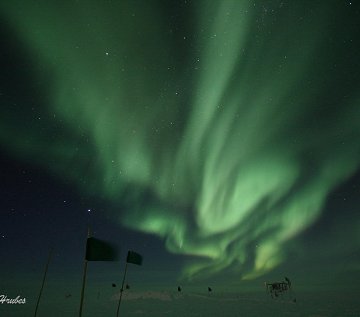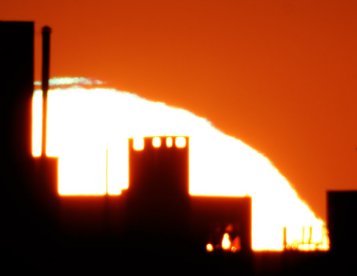| AURORA ALERTS: Did you miss the Northern Lights of June 14th? Next time get a wake-up call from Space Weather PHONE. | | | ALERT! Russian amateur astronomer Oleg Pomogaev reports "very bright noctilucent clouds over Moscow tonight": photos. If it persists, the display may be visible later this evening over Scandinavia, the British Isles, Canada and Alaska. If you live in those areas, be alert for NLCs. AURORA SURPRISE: Last night, an unexpected geomagnetic storm sparked bright auroras over Earth's poles. The arctic half of the display was subdued by summer sunlight, but the antarctic half was a doozy. J. Dana Hrubes sends this picture from the Amundsen-Scott Station at the geographic South Pole: 
Hrubes is "wintering over" at Amundsen-Scott as the station's Science Leader. One of his jobs is tending to the South Pole Telescope, silhouetted here by the aurora australis. Affectionately known as "Spot", the telescope takes advantage of the South Pole's steady skies and long nights to study dark matter and the origins of the Universe. Excuse the interruption! More auroras are possible on June 26th and 27th when a minor solar wind stream is expected to hit Earth's magnetic field. Stay tuned. June 2008 Aurora Gallery
[Aurora Alerts] [Night-sky Cameras] PANCAKES, SOME FLIPPED: On June 15th, Danilo Linhares photographed the sun setting behind apartments in his hometown, Curitiba, Brazil. Later when he looked at the pictures, he discovered that a pancake-thin slice of sun had detached from the rest of the star. Solar System Calamity!? No, it was just a mirage: 
Photo details: Celestron C8, Canon 350D, ISO 100, 1/2000s exposure
Atmospheric optics expert Les Cowley explains: "Mirages can slice up the sun into stacked pancakes when it is near the horizon and a slice near the top might turn, like this one, into a green flash. The mirages can flip the pancakes too so that two descend and set while a third rises. Layers of air at unusual temperatures produce these sunset spectacles for us." more mirages: from Jeff Hapeman of Santa Monica, CA; from Mark Parrish of West Beach, Selsey UK; from Mila Zinkova of San Francisco, California;
2008 Noctilucent Cloud Gallery
["Noctilucent Clouds"--the song] [Night-sky Cameras] | 
